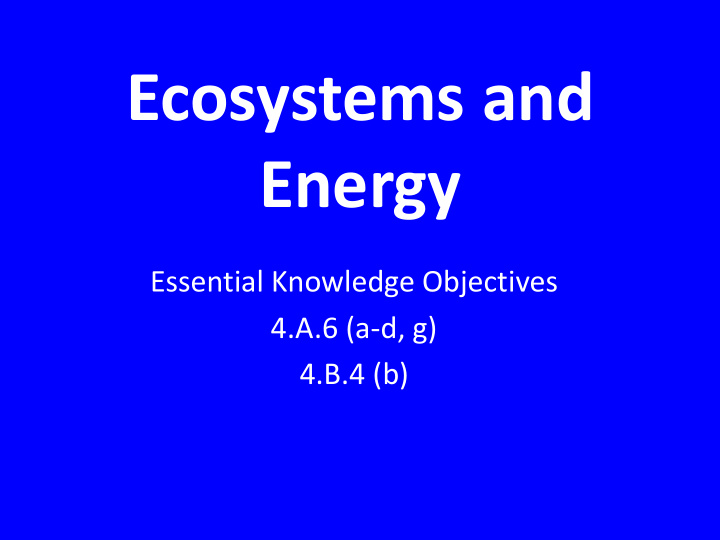



Ecosystems and Energy Essential Knowledge Objectives 4.A.6 (a-d, g) 4.B.4 (b)
Matter and Energy • Energy enters, flows through, and exits an ecosystem • Matter cannot be created or destroyed, but it can change form (recycled) – law of conservation of mass • Chemical nutrients cycle within ecosystems through biogeochemical cycles (carbon, nitrogen, phosphorus, water)
Matter and Energy • Energy enters from the sun as radiation , moves as chemical energy transfers through food webs, and exits as heat radiated back into space
Matter and Energy
Energy Flow in Ecosystems • Energy flows through ecosystems from the sun through producers to consumers • Organisms within food webs and food chains interact • Food webs and food chains are dependent on primary productivity
Primary Producers (Phototrophs) • Plants, photosynthetic protists (algae), chemosynthetic and photosynthetic bacteria (cyanobacteria) • Convert solar energy into chemical energy (glucose) through photosynthesis
Primary Producers (Chemotrophs) • Chemosynthetic bacteria (prokaryotes) are the primary producers of the deep-sea hydrothermal vent communities • Convert inorganic chemicals (CO 2 , H 2 S, CH 4 ) into organic molecules (sugars) through chemosynthesis
Primary Productivity • Primary productivity : The amount of light energy converted to chemical energy (organic molecules) by autotrophs (photosynthetic and chemosynthetic) during a given time period in an ecosystem • Influenced by changes in regional and global climates and in atmospheric composition
Primary Productivity • Food webs and food chains are dependent on primary productivity – why? • Represents the storage of chemical energy that will be available to consumers in an ecosystem
GPP and NPP • Gross primary productivity (GPP) : total primary production in an ecosystem (the amount of energy from light, or chemicals, converted to chemical energy of organic molecules per unit time • Net primary productivity (NPP): equal to the GPP minus the energy used by the primary producers for autotrophic respiration
Net Primary Productivity (NPP) (write down the equation below in your notes)
Global Primary Production
Terrestrial Primary Production
Terrestrial Primary Production • Temperature and moisture are the main factors controlling primary production in terrestrial ecosystems
Aquatic Primary Production
Aquatic Primary Productivity • Ocean phytoplankton are responsible for approximately 50% of the global biosphere net primary production • Global annual ocean primary production has decreased due to an increase in global sea surface temperature – why? (thermocline) • Light and nutrients are limiting factors
Light and Nutrient Limitation • Solar radiation drives photosynthesis (not the only variable controlling primary production) • Limiting nutrients are elements that must be added for production to increase, such as nitrogen and phosphorus
Consumers (Heterotrophs) • Herbivores, carnivores, omnivores, detritivores, decomposers
Role of Decomposers
Trophic Levels and Ecological Pyramids
Trophic Levels • A trophic level is the position that an organism occupies in a food chain or food web (what it eats, what eats it)
Ecological Pyramids • Graphical representations designed to show the biomass or bioproductivity at each trophic level in a given ecosystem • Energy pyramid, biomass pyramid, and pyramid of numbers
Energy Pyramid • A graphical representation of energy flow in a community of organisms
Trophic Efficiency • Trophic efficiencies are generally only about 10% (90% of the energy available at one trophic level not passed on)
Trophic Efficiency
Pyramid of Net Production
Biomass Pyramid and Numbers Pyramid • Biomass pyramids represent the total dry mass of all organisms in one trophic level • Numbers pyramids show the number of individual organisms in one trophic level
Recommend
More recommend